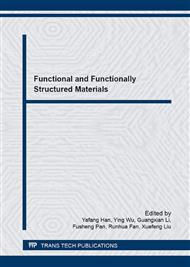[1]
D.K. Han, Q.C. Chen, J.Q. Wang, Design of magnetic circuit of magnetron sputtering target, VACUUM. 44 (2007) 14-17.
Google Scholar
[2]
Heraeus, Inc, U. S. Patent 006514358B1. (2003).
Google Scholar
[3]
Nippon Mining & Metal Co., Ltd, U. S. Patent 7740718B2. (2010).
Google Scholar
[4]
Praxair S.T. Technology, Inc., U.S. Patent 6190516B1. (2001).
Google Scholar
[5]
W.J. Xu, Recent developments and applications in magnetron sputtering, Modern Instruments. 11 (2005) 1-5.
Google Scholar
[6]
W.M. Yang, Y.W. Liu, L.X. Xu, etc. Review of film growth by sputtering technology, Journal of Vacuum Science and Technology (CHINA). 25 (2005) 204-205.
Google Scholar
[7]
Z. Liu, The Calculation of Electromagnetic Distribution and Particle Movement in Magnetron Sputtering Equipment, Hefei University of Technology, He Fei, (2007).
Google Scholar
[8]
C.S. Yang, H.F. Cheng, G.P. Tang, etc. Review of ferromagnetic targets for magnetron sputtering, Journal of Vacuum Science and Technology (CHINA). 25 (2005) 372-377.
Google Scholar
[9]
ASTM F1761-00, Standard Test Method for Pass Through Flux of Circular Magnetic Sputtering Targets, ASTM International, (2005).
Google Scholar
[10]
General Research Institute for Nonferrous Metals, Grikin Advanced Materials Co. Ltd, China Patent 200920350675. 3. (2010).
Google Scholar
[11]
General Research Institute for Nonferrous Metals, Grikin Advanced Materials Co. Ltd, China Patent 200620134206. 4. (2007).
Google Scholar
[12]
G.X. Hu, X. Cai, Y.H. Rong, Fundamentals of Materials Science, third ed., Shang Hai Jiao Tong University Press, Shang Hai, (2010).
Google Scholar
[13]
L.H. Zhang, Y. An, The qualitative analysis of the structure of the magnetism farmland as source of the minimum energy principle, Journal of Hebei Institute of Technology. 27 (2005) 105-121.
Google Scholar
[14]
X. Chen, Basic Research about Mechanism of Magnetic Memory Method, Nan Chang Hang Kong University, Nan Chang, (2007).
Google Scholar
[15]
J.J. Liu, The influence of the residual stress on magnetic property of soft magnetic materials, Hangkong Bingqi. (2004) 28-31.
Google Scholar
[16]
M.X. Xu, Research on The Magnetic Effects of Ferromagnetic Material in The Process of Fatigue, Harbin Institute of Technology, Harbin, (2012).
Google Scholar


